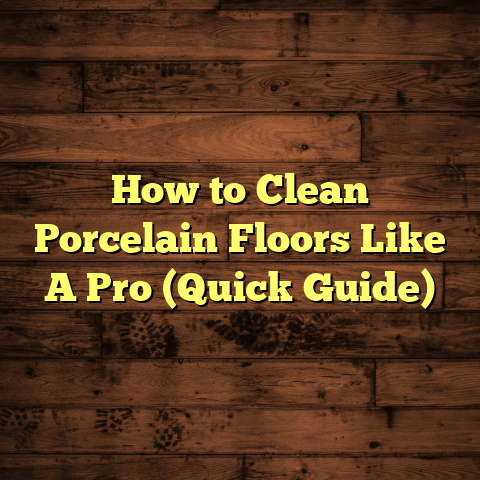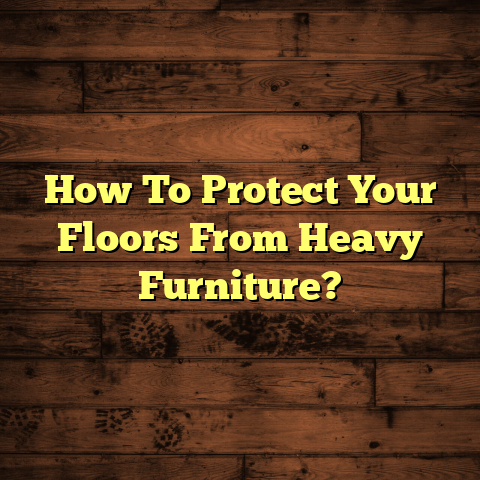What Goes Under Hardwood Flooring? [Crucial Prep Steps]
Did you know that around 90% of homeowners consider hardwood flooring as their top choice for flooring? It’s no surprise, given its beauty and durability. As someone who has spent years in the flooring industry, I’ve had my fair share of experiences with hardwood floors. Today, I want to share insights on what goes under hardwood flooring, based on my journey as a contractor.
The Foundation Matters
When I first started working with hardwood flooring, I quickly learned that what goes beneath it is just as important as the flooring itself. The right underlayment can make a significant difference in how the floor performs and feels.
Types of Underlayment
- Foam Underlayment
- Description: This is one of the most common options. Made from polyethylene or polystyrene foam, it provides cushioning and sound absorption.
- My Experience: I remember a project where we installed foam underlayment in a living room. The homeowner was thrilled with the sound reduction. It’s great for reducing noise between floors, especially in multi-story homes.
- Installation Tips: When laying foam underlayment, make sure to butt the edges tightly together without overlapping. This helps prevent moisture from seeping through.
- Cork Underlayment
- Description: Cork is a natural option that offers excellent sound insulation and thermal resistance.
- How It Helped: I had a client who lived in a noisy neighborhood. Using cork made a noticeable difference, creating a quieter home environment.
- Sustainability Factor: One of the reasons I enjoy using cork is its eco-friendliness. It’s harvested from cork oak trees without harming them, making it a renewable resource.
- Rubber Underlayment
- Description: This material is durable and provides excellent soundproofing.
- Challenges Faced: While rubber is effective, it can be more expensive. I had to explain this to a client who was initially set on budget-friendly options. But once they understood the long-term benefits, they were on board.
- Performance: Rubber is particularly effective in spaces like gyms or playrooms where impact noise can be a concern.
- Combination Underlayment
- Description: Some products combine materials for enhanced performance, like foam with a moisture barrier.
- Success Story: During a recent installation in a basement, using combination underlayment helped prevent moisture issues while also providing cushioning. The client reported no signs of moisture-related problems post-installation.
Why Underlayment Is Important
You might wonder why all of this matters. The underlayment affects:
- Comfort: A good underlayment provides cushioning, making walking on the hardwood feel much nicer.
- Sound: Proper sound absorption reduces echo and noise, enhancing the overall comfort of your home.
- Moisture Protection: In areas prone to moisture, like basements, selecting the right underlayment can prevent damage.
I once worked on a project where the homeowner skipped underlayment to save costs. Unfortunately, they faced squeaking floors and increased noise levels. They ended up returning to have it done right.
Installation Process
When installing hardwood flooring, I follow a systematic approach:
- Preparation: The subfloor must be clean and dry. Any debris can affect the installation.
- Cleaning: Before installation begins, I always make sure to sweep and vacuum thoroughly. If there are any stains or spills on the subfloor, those need to be addressed.
- Underlayment Installation: Depending on the type chosen, I roll out foam or lay cork sheets, ensuring seams are staggered.
- Overlap Prevention: I usually recommend sealing seams with tape for foam underlayment to prevent moisture penetration.
- Laying Hardwood: Once the underlayment is down, I proceed with laying the hardwood.
- Expansion Gaps: It’s essential to leave gaps for expansion around the perimeter of the room; this can prevent buckling later on.
- Final Touches: After laying down the hardwood floor, I check for any squeaks or uneven areas before proceeding with baseboards or trim installation.
Cost Considerations
Cost can vary widely based on the type of underlayment you choose. On average:
- Foam: $0.30 to $0.50 per square foot
- Cork: $0.80 to $1.20 per square foot
- Rubber: $1.00 to $1.50 per square foot
Using FloorTally has been invaluable for me in estimating these costs accurately. The platform pulls local material prices, allowing me to provide clients with realistic budgets upfront.
Example Budgeting Scenario:
Let’s say a client wants to install hardwood flooring in their 1,000 square foot living room:
- Foam Underlayment Cost: 1,000 sq ft x $0.40 = $400
- Cork Underlayment Cost: 1,000 sq ft x $1.00 = $1,000
- Rubber Underlayment Cost: 1,000 sq ft x $1.25 = $1,250
By using FloorTally, I can quickly show clients how different choices affect their overall budget.
Maintaining Hardwood Floors
Once the installation is complete, maintenance is key to longevity:
- Regular Cleaning: Sweeping or vacuuming helps remove dirt and debris.
- I always advise clients to avoid wet mopping hardwood floors because excess moisture can lead to warping.
- Moisture Control: Using humidity control products can prevent warping.
- In humid climates, using dehumidifiers during summer months can help maintain stability in hardwood flooring.
- Refinishing: Depending on wear, refinishing every 5-10 years can restore beauty.
- I often recommend using oil-based finishes for durability; they tend to last longer than water-based options.
Tips for Homeowners
- Consider Your Environment: If you live in a humid area, prioritize moisture-resistant underlayment.
- Think About Noise Levels: For multi-story homes, sound-dampening underlayment can enhance comfort.
- Get Samples: Before deciding, always request samples to see how different underlayments feel underfoot.
Challenges and Solutions
Not every installation goes smoothly. In one project, we discovered that the subfloor was uneven, leading to challenges when laying hardwood. We had to level it out using a self-leveling compound, which added time and cost but ultimately resulted in a better finish.
Dealing with Moisture Issues
In another instance, I encountered significant moisture issues in an older home’s basement. After thorough testing with a moisture meter, we found that the subfloor was retaining too much moisture for hardwood installation alone.
- Solution: We opted for a combination underlayment specifically designed for moisture control along with a vapor barrier underneath it. This approach not only protected the hardwood but also gave the homeowners peace of mind.
Real-Life Examples
I remember working on a project for a family who had recently renovated their home. They wanted hardwood floors throughout but were uncertain about what went beneath them.
After assessing their needs and budget constraints, we decided on foam underlayment due to its affordability and sound-dampening qualities. The family loved how quiet their home became after installation—no more thumping sounds from kids running around upstairs!
Conversely, I had another client who insisted on skipping underlayment entirely to save costs. After some discussion about potential issues like noise and discomfort from walking on hard surfaces, they agreed to reconsider. We chose cork underlayment together; they reported back post-installation that it felt like a completely different space!
How Different Options Compare
When deciding what goes underneath your hardwood flooring, it helps to compare options side by side:
| Type | Cost (per sq ft) | Sound Insulation | Moisture Resistance | Comfort Level |
|---|---|---|---|---|
| Foam | $0.30 – $0.50 | Moderate | Low | Moderate |
| Cork | $0.80 – $1.20 | High | Moderate | High |
| Rubber | $1.00 – $1.50 | Very High | High | High |
| Combination | Varies | High | Very High | High |
This comparison table has helped countless clients make informed decisions by visually understanding their options.
Conclusion
Choosing the right underlayment for hardwood flooring is vital for ensuring comfort, sound reduction, and moisture protection. My experiences have taught me that taking the time to select quality materials pays off in the long run.
Whether you’re a contractor or a homeowner looking to install hardwood flooring, understanding what goes beneath it can greatly influence the final outcome. The right choices lead to beautiful, lasting results that you’ll enjoy for years to come.
If you’re considering your options or need advice on an upcoming project, feel free to reach out!

![How to Eliminate Pet Odor From Hardwood Floors? [Quick Fix!]](https://floortally.com/wp-content/uploads/2025/01/How-To-Eliminate-Pet-Odor-From-Hardwood-Floors.png)
![How To Deep Clean Tile Floors With Vinegar? [Quick Guide]](https://floortally.com/wp-content/uploads/2025/01/How-To-Deep-Clean-Tile-Floors-With-Vinegar.png)



![Floor Warping: What It Is and How To Fix It [Fast]](https://floortally.com/wp-content/uploads/2025/01/What-Is-Floor-Warping.png)